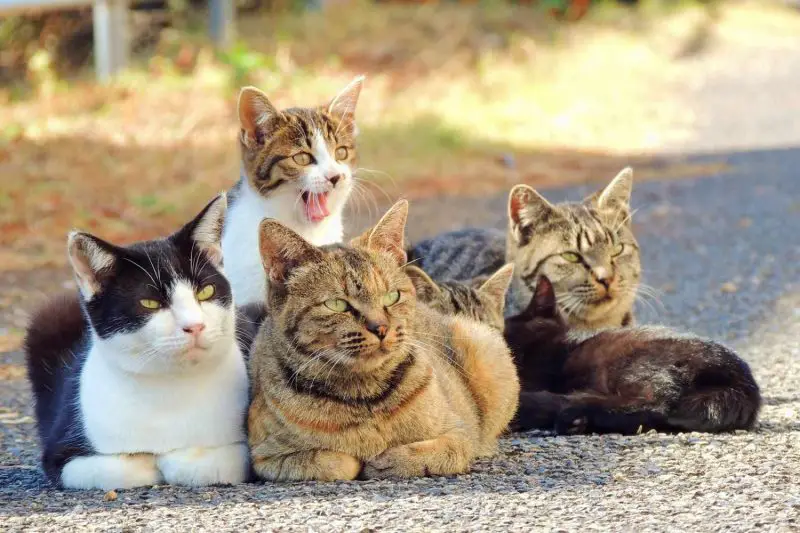Cats, known for their independent nature, are often seen lounging alone or wandering the neighborhood. However, when they come together in groups, it’s a sight to behold! You may have wondered, what is a group of cats called? If so, you’re not alone. The term for a group of cats is not as straightforward as it might seem.
In this detailed guide, we will explore what a group of cats is called, dive into the fascinating facts about feline groups, and uncover the historical and cultural significance of these terms.
What is a Group of Cats Called?

The simple answer is that a group of cats is called a “clowder.” This term is widely recognized and used in the English language to refer to a gathering of domestic cats. The word “clowder” has its roots in Middle English, derived from the word “clodder,” meaning a lump or mass, possibly referring to the compact nature of cats when they gather together.
But the term “clowder” is not the only way to describe a group of cats. In fact, there are a few other names used in different contexts or for specific types of feline groupings. Let’s explore these in more detail.
The Different Names for a Group of Cats
While “clowder” is the most commonly used term, there are other terms that may apply to groups of cats under specific conditions. Let’s take a look at these alternatives:
1. Glaring
A “glaring” refers to a group of cats who are often seen together, usually exhibiting some level of animosity or standoffish behavior. This term highlights the intense, sometimes confrontational nature that cats may display when gathered together, especially if there are territorial disputes.
2. Clutter
While “clowder” is more widely recognized, “clutter” is another term occasionally used to describe a group of cats. It evokes the idea of a disorganized, somewhat chaotic group, which may be fitting given the unpredictable nature of cats.
3. Kittens
If the group consists solely of young cats, they are called “kittens.” This term doesn’t refer to a specific number of kittens but simply describes a group of cats that are still in the juvenile stage of life.
4. Cat’s Parade
In some cases, especially in folklore, a group of cats can be referred to as a “cat’s parade,” likely due to their graceful, rhythmic movements as they move together. This term captures the elegance cats can exhibit when in motion.
Why Do Cats Form Groups?
Cats are often thought of as solitary creatures, but in reality, they can form strong bonds and group dynamics, especially in environments where they have enough resources. Let’s take a closer look at why cats may form groups.
1. Mutual Protection
One reason cats may form groups is for mutual protection. In the wild, cats can benefit from being part of a group where they help look out for each other against predators or rival animals. Although domesticated cats don’t face the same dangers, feral cats living in colonies still rely on one another for safety.
2. Shared Resources
Cats are territorial by nature, but they can also learn to share resources when necessary. A group of cats in the wild or in a multi-cat household may share food, shelter, and grooming opportunities, fostering cooperation.
3. Social Bonds
While cats are often solitary, many can form strong social bonds with others, especially if they are raised together or introduced gradually. Some cats thrive on companionship and can form close-knit social groups, engaging in activities such as grooming each other, playing, and resting together.
Fun Facts About Groups of Cats
Now that we’ve answered the question of what a group of cats is called, let’s dive into some fascinating and fun facts about these unique feline groupings.
1. Cats Can Have “Feline Hierarchies”
In a group of cats, there may be a hierarchy, often referred to as a “pecking order.” This hierarchy is not rigid, but it does help maintain order within the group. The dominant cat, often the oldest or most assertive, will lead the group, while others take on varying roles depending on their personalities. Interestingly, the hierarchy in a group of cats can shift over time as cats grow older or as new cats join the group.
2. Clowders Are Not Always Peaceful
While you might imagine a group of cats lounging around together in harmony, clowders are not always peaceful. Cats, being territorial by nature, can sometimes clash when multiple cats are living in close proximity. Territorial disputes are common, especially if a new cat is introduced to an established group.
3. Feral Cat Colonies Are Larger Than You Think
Feral cats tend to form larger groups known as colonies. These colonies may consist of dozens, or even hundreds, of cats depending on the resources available. Feral cats in these colonies often have a complex social structure where different individuals specialize in hunting, protecting the colony, or caring for the young. Unlike domesticated cats, feral cats rely on each other for survival, forming strong bonds.
4. A Group of Cats Can Be Extremely Independent
Even in a clowder or group setting, each cat maintains its individualistic traits. They are often seen lounging separately, grooming themselves, or choosing their own resting spots. However, when it comes to important activities like hunting or protecting the group, they can work together in a surprisingly coordinated manner.
5. Cats May Have Different Roles in Groups
In a group, not all cats will have the same behavior or role. Some may be more active and playful, others more reserved, and some may take on the role of “leader.” Interestingly, cats in groups often learn from each other, and more dominant cats may show younger or shyer cats how to hunt, groom, or defend their territory.
The History Behind Group Terms for Cats
The terms used for groups of cats, such as “clowder” and “glaring,” have a long history, with many originating from Middle English. These words often reflect the behavior of the cats in question or the way they interact when gathered together.
For example, “clowder” likely derives from the Old English term for a lump or mass, reflecting how cats may bunch together in close proximity. On the other hand, “glaring” evokes the sharp, intense stares that cats often give one another, especially when they are not particularly fond of each other.
Cats in Culture and Folklore
Cats have been a subject of fascination in various cultures for centuries, with their behaviors often influencing the way they are depicted in folklore. In some cultures, cats are revered as protectors and symbols of mystery, and their social behaviors have been associated with magic and even superstition.
In medieval Europe, cats were believed to possess mystical powers, and they were often portrayed as solitary creatures. However, their ability to form groups in the wild has led to different interpretations of their social dynamics. For example, some folklore suggests that a “cat’s parade” or a group of cats wandering together could bring good luck or foretell important events.
Cats and Humans: Coexisting in Groups
In a household with multiple cats, humans often observe their pets’ social behavior and group dynamics. Whether it’s two cats or five, many people wonder if their cats get along or if they’re forming their own little clowder. Understanding how cats interact can help owners manage their multi-cat households.
1. Introducing Cats to Each Other
Introducing a new cat to an existing group can be a delicate process. It’s important to allow time for gradual introductions, as cats may need space to adjust to a new addition. Start by keeping the new cat in a separate room and slowly allowing them to sniff each other through a door. Over time, supervised interactions can help ease the transition.
2. Creating a Peaceful Multi-Cat Home
To create a peaceful multi-cat household, it’s essential to provide ample resources, such as food, water, litter boxes, and places to rest. Having enough space and resources ensures that the cats don’t feel threatened by competition. Observing your cats’ behavior and responding to their needs can also help maintain harmony in the household.
3. Cats and Their Humans: A Special Bond
Despite their reputation for being independent, cats can form strong bonds with their human companions. Many cat owners report that their pets have distinct personalities and behaviors that reflect their comfort within the household. Some cats may follow their owners around, while others prefer a more distant relationship. Understanding and respecting your cat’s boundaries is crucial for maintaining a happy household.
Conclusion
So, what is a group of cats called? The most common answer is a “clowder,” but there are also terms like “glaring” and “clutter” that can be used in different contexts. Cats may not always thrive in groups, but when they do form clowders, it’s an interesting dynamic to observe. From the mutual protection and shared resources to the independent personalities that each cat brings to the table, feline groups are truly unique.
Whether you’re watching a group of cats at the shelter, observing feral colonies, or managing a multi-cat household, understanding the behavior of cats in groups can give you a deeper appreciation for these fascinating creatures. Now that you know what a group of cats is called, you can impress your friends with your knowledge of feline social behavior!






